Fostex VM88 Owners Manual
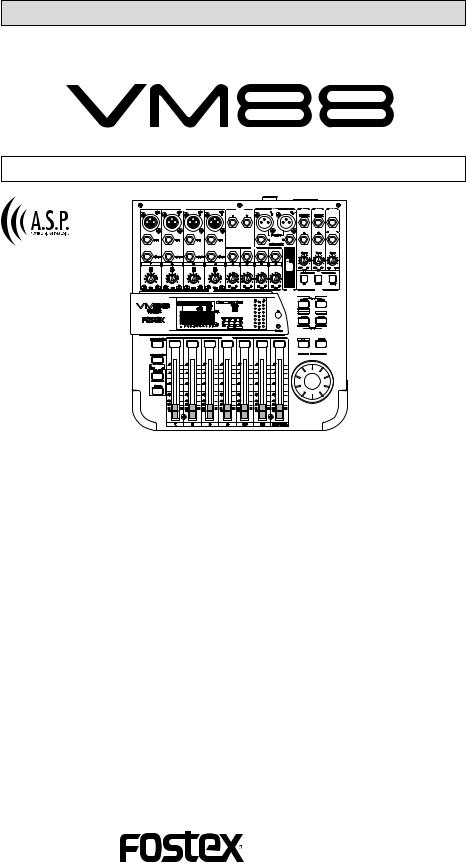
Owner’s Manual
Model
Eight Channel Digital Mixer with DSP Effects
Introduction
Thank you very much for purchasing the Fostex VM88.
Please read the following to get the most satisfaction from your purchase, and to learn important information about safety precautions when using Fostex products.
The VM88 digital mixer does all internal signal processing digitally.
The input features 8 analog channels, of which 4 channels (XLR or PHONE) are for microphones; digital inputs (S/P DIF or ADAT) via optical connection are provided. For outputs, an optical digital output (S/P DIF or ADAT) in addition to stereo out (balanced/unbalanced), headphone out, AUX send/out and monitor outs in analog are also provided. An insert function is featured in channels 1 - 4 for more flexibility during mixing.
In addition to each input channel, an three band EQ is also provided for the master output. The VM88 also incorporates high performance DSP multi-effects on two channels that operate by A.S.P. (Fostex Advanced Signal Processing Technology*) exclusively developed by Fostex. This allows a wide range of equalizing and effects processing. All settings, including mix and effects settings, are stored in scene memory, and a desired scene memory can be recalled instantaneously. Although small and lightweight, the VM88 is a high performance unit. Please read this manual carefully before operation to understand all functions of the VM88.
* See page 24 for more details on the A.S.P. (Fostex Advanced Signal Processing Technology).
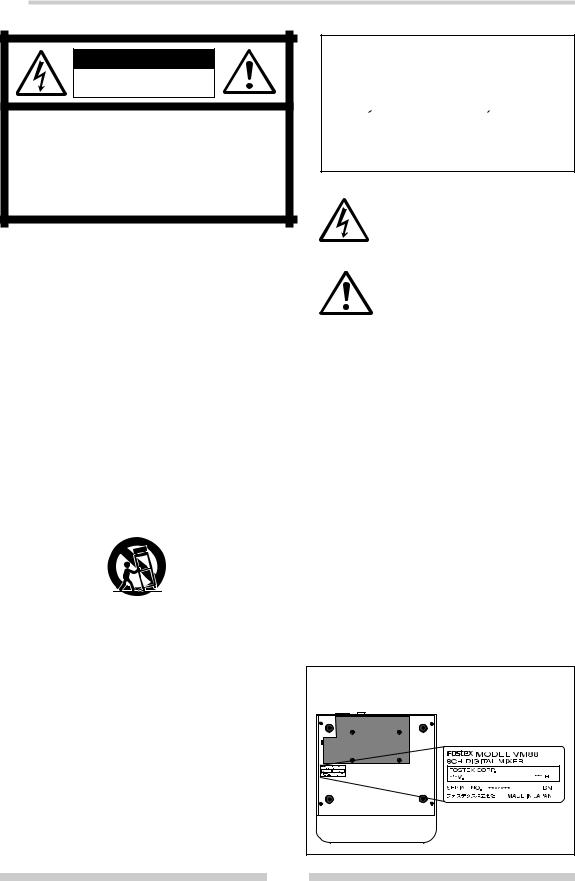


 Model VM88 Owner’s Manual
Model VM88 Owner’s Manual
CAUTION
RISK OF ELECTRIC SHOCK
DO NOT OPEN
CAUTION: TO REDUCE THE RISK OF ELECTRIC SHOCK,
DO NOT REMOVE COVER (OR BACK).
NO USER - SERVICEABLE PARTS INSIDE.
REFER SERVICING TO QUALIFIED SERVICE PERSONNEL.
"WARNING"
"TO REDUCE THE RISK OF FIRE OR ELECTRIC SHOCK, DO NOT EXPOSE THIS APPLIANCE TO RAIN
OR MOISTURE."
SAFETY INSTRUCTIONS
1.Read Instructions - All the safety and operating instructions should be read before the appliance is operated.
2.Retain Instructions - The safety and operating instructions should be retained for future reference.
3.Heed Warnings - All warnings on the appliance and in the operating instructions should be adhered to.
4.Follow Instructions - All operating and use instructions should be followed.
5.Water and Moisture - The appliance should not be used near water - for example, near a bathtub, washbowl, kitchen sink, laundry tub, in a wet basement, or near a swimming pool, and the like.
6.Carts and Stands - The appliance should be used only with a cart or stand that is recommended by the manufacturer.
An appliance and cart combination should be moved with care. Quick stops, excessive force, and uneven surfaces may cause the appliance and cart combination to overturn.
7.Wall or Ceiling Mounting - The appliance should be mounted to a wall or ceiling only as recommended by the manufacturer.
8.Ventilation - The appliance should be situated so that its location or position dose not interfere with its proper ventilation. For example, the appliance should not be situated on a bed, sofa, rug, or similar surface that may block the ventilation openings; or, placed in a built-in installation, such as a bookcase or cabinet that may impede the flow of air through the ventilation openings.
9.Heat - The appliance should be situated away from heat sources such as radiators, heat registers, stoves, or other appliances (including amplifiers) that produce heat.
10.Power Sources - The appliance should be connected to a power supply only of the type described in the operating instructions or as marked on the appliance.
11.Grounding or Polarization - The precautions that should be taken so that the grounding or polarization means of an appliance is not defeated.
CAUTION:
TO PREVENT ELECTRIC SHOCK, MATCH WIDE BLADE
OF PLUG TO WIDE SLOT, FULLY INSERT.
ATTENTION:
P O U R E V I T E R L E S C H O C S E L E C T R I Q U E S ,
INTRODUIRE LA LAME LA PLUS LARGE DE LA FICHE
DANS LA BORNE CORRESPONDANTE DE LA PRISE
ET POUSSER JUSQU' AU FOND.
The lightning flash with arrowhead symbol, within an equilateral triangle, is intended to alert the user to the presence of uninsulated "dangerous voltage" within the product's enclosure that may be of sufficient magnitude to constitute a risk of electric shock to persons.
The exclamation point within an equilateral triangle is intended to alert the user to the presence of important operating and maintenance (servicing) instructions in the literature accompanying the appliance.
12.Power Cord Protection - Power supply cords should be routed so that they are not likely to be walked on or pinched by items placed upon or against them, paying particular attention to cords at plugs, convenience receptacles, and the point where they exit from the appliance.
13.Cleaning - The appliance should be cleaned only as recommended by the manufacturer.
14.Nonuse Periods - The power cord of the appliance should be unplugged from the outlet when left unused for a long period of time.
15.Object and Liquid Entry - Care should be taken so that objects do not fall and liquids are not spilled into the enclosure through openings.
16.Damage Requiring Service - The appliance should be serviced by qualified service personnel when:
A.The power supply cord or the plug has been damaged; or
B.Objects have fallen, or liquid has been spilled into the appliance; or
C.The appliance has been exposed to rain; or
D.The appliance does not appear to operate normally or exhibits a markedchange in performance; or
E.The appliance has been dropped, or the enclosure damaged.
17.Servicing - The user should not attempt to service the appliance beyond that described in the operating instructions.
All other servicing should be referred to qualified service personnel.
<IMPORTANT! >
Equipment name, electrical ratings, serial number and other information for the VM88, are written on bottom side.
2

Table of Contents |
|
Precautions............................................ |
2 |
Names and Functions........................... |
4 |
Top panel section........................................... |
4 |
Rear panel section.......................................... |
7 |
Block Diagram........................................ |
7 |
Before Operation................................... |
8 |
Remove the insulation paper....................... |
8 |
Reset of VM88................................................. |
8 |
Internal battery for the memory back up... |
8 |
Peripheral Equipment Connection..... |
9 |
Application Examples........................ |
12 |
Initial State of the VM88....................... |
14 |
Normal Mix Mode................................. |
15 |
Muting the input/master channels.......... |
16 |
On and off of the stereo output L, R.......... |
16 |
Select of the monitor signals...................... |
17 |
Input/output of an digital signals............. |
18 |
Channel Parameter Edit Mode.......... |
20 |
Setup method for PAN setting.................... |
20 |
EQ setup method.......................................... |
21 |
Setup method of the effect send level....... |
21 |
Setup method of the aux send level.......... |
22 |
PRE/POST setup method............................ |
23 |
Effect Edit Mode................................... |
24 |
About the effect types................................. |
25 |
Selecting the effect type.............................. |
26 |
Effect parameter settings............................ |
27 |
Muting an effect........................................... |
27 |
Effect parameter details.............................. |
28 |
Scene Memory Mode.......................... |
30 |
Storing a scene memory............................. |
30 |
Recalling a scene memory.......................... |
30 |
Level adjust.................................................. |
31 |
Fader adjust................................................. |
31 |
Directly recalling a scene memory........... |
32 |
Clearing a scene memory........................... |
32 |
Setup Mode.......................................... |
33 |
Making settings in setup mode.................. |
33 |
Details of the setup menu........................... |
34 |
Setup of the SYSTEM CLOCK.......................... |
34 |
Setup of DIGITAL IN........................................ |
34 |
Setup of DIGITAL OUT.................................... |
35 |
Setup of phantom power ON/OFF................. |
35 |
Setup of peak hold time.................................. |
35 |
Model VM88 Owner’s Manual |
|
Setup of input mode for INPUT 5/6.............. |
35 |
Setup of input mode for INPUT 7/8.............. |
36 |
Setup of the fader fix mode............................ |
36 |
Setup of the channel fader recall mode........ |
36 |
Setup of the master fader recall mode.......... |
36 |
Setup of the foot switch function.................. |
37 |
Voltage check of the internal battery........... |
37 |
The Options.......................................... |
38 |
Specifications...................................... |
39 |
Precautions (please read before use)
Power Supply
*When unplugging the power cable the outlet, be sure to grasp the adaptor. Attempting to unplug it by pulling on the AC cable may damage the wiring.
*It is dangerous to use any power cable that is cut or frayed. If the power cable is damaged, immediately stop using it, and have it repaired.
*Do not plug in or unplug the power cable with wet hands. Doing so may result in dangerous electric shock.
*Do not open the unit or touch any parts inside. Doing so may result in a dangerous electric shock, and could damage the unit.
*Do not let water or other liquids, flammable materials, or metal objects such as pins get in side the unit.
These things may cause electric shock or short circuit the VM88, and damage it. If the VM88 should become wet, unplug the power cable from the AC outlet, and contact your authorized service station.
Location
Avoid using the VM88 in the following locations:
*Locations of extreme low or high temperatures, or extreme changes in temperature.
*Locations with excessive moisture or dust.
*Locations where direct sunlight falls for an extended time, or near a stove or other source of heat.
*Locations where electrical voltage varies.
*Unstable locations or where there is heavy vibration.
*Near strong magnetic fields (on top of a television or speaker).
3
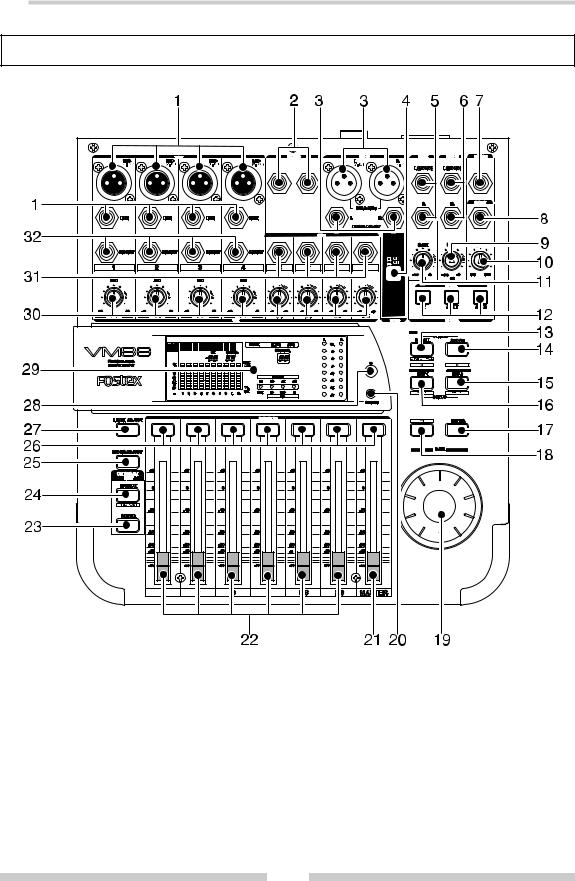


 Model VM88 Owner’s Manual
Model VM88 Owner’s Manual
Names and Functions
Top panel section
1. Input connector
External sound sources are input here.
MIC 1 - 4 are for Canon connectors (XLR-3-31; pin 2=hot), which comply to mic/line signals. The input gain can be trimmed within a range of -50dBu ~ - 10dBu. Because phantom power is available at these connectors, condenser mics can also be connected. LINE 1 ~ 4 are TRS phone jacks exclusively for line inputs and each input gain can be trimmed the same as with MIC 1 ~ 4, within a range of -30dBu ~ +10dBu. For details, please refer to “Connecting peripheral equipment” on page 9.
2. AUX send jack
AUX SEND level signal adjusted in the channel parameter edit mode is output here. For details on adjusting the output signals, refer to “Channel parameter edit mode” on page 20.
3. Stereo out connector
The mixed signal to be input to an MTR or other mixer is output from this connector. Connectors for balanced output (XLR-3-32 type) and unbalanced output (phone) are provided and the output level can be adjusted by the MASTER fader. The output signal can be switched on/off by the ST OUT ON/ OFF switch.
4

4. Stereo out ON/OFF switch
Stereo out signal ON/OFF is controlled by this switch. For details, please refer to “Normal mix mode” on page 15.
5. Monitor in jack
External signals are input here.
The input signal is adjusted via the MON IN GAIN knob and directly mixed into the monitor circuit, so that it can be monitored at the PHONES and MON OUT L, R jacks together with a monitor signal selected by the MON SEL switch.
6. Monitor out jack
Powered monitoring speakers or an amplifier + speaker combination are plugged in here. The signal to be monitored is selected by the MON SEL switch and the output is adjusted with the MON OUT GAIN knob. For details, please refer to “Connecting peripheral equipment” on page 9.
7. Foot switch connecting jack
A foot switch (Fostex Model 8051) is plugged in here. The foot switch function can be changed by the [SETUP mode] explained later. The initial setting recalls the scene memory. Refer to page 33 for details.
8. Headphone jack
The monitoring headphone is connected here.
Use the PHONES GAIN control to adjust the sound level.
9. Monitor output adjusting knob
This controls the sound volume at the MON OUT L, R jacks.
10. Headphone volume
This adjusts the monitor headphone sound volume.
11. Monitor input adjusting knob
Use this to adjust the input signal level from the MON IN jack.
12. Monitor select switch
This is for selecting the monitor signal to be output at the MON OUT L, R and PHONES jacks. Either one signal in the stereo buss, AUX 1 buss or AUX 2 buss can be selected.
13. Scene Recall key
This is pressed to recall the scene memory explained later. Refer to [Recall of the scene memory] on page 30 for details.
14. Scene Store key
This is pressed to store a scene memory. Refer to [Storing the scene memory] on page 30 for details.
15. Effect 2 key
This is pressed to select the EFF 2 effects type or the parameter to be edited. Also, if this key is pressed while pressing the EXIT key, muting of EFF 2 can be
Model VM88 Owner’s Manual 


switched ON/OFF. Refer to [Effect edit mode] on page 24 for details.
16. Effect 1 key
This is pressed to select the EFF 1 effects type or the parameter to be edited. Also, if this key is pressed while pressing the EXIT key, muting of EFF 1 can be switched ON/OFF. Refer to [Effect edit mode] on page 24 for details.
17. Enter key
This is used to accept the current mode setting. This key will setup scene memory mode (page 30), the setup mode (page 33) and also the setup of effects type (page 26). Please refer to their respective explanation for details.
18. Exit key
This is used to exit from all modes but the normal mix mode. This key works for the channel parameter edit mode (page 20), the effects edit mode (page 24), the scene memory mode (page 30) and the setup mode (page 33). Refer to their respective explanations for details.
19. Data encoder
This dial is rotated to make settings such as setup of PAN and EQ. This dial works in the channel parameter edit mode (page 20), the scene memory mode (page 30) and the effects edit mode (page 24). Refer to their respective explanations for details.
20. Phantom LED
When the phantom power supply ON/OFF setting in the setup mode is set to ON, the LED will light but and extinguish when set to OFF. The phantom power supply is OFF from the factory. For details on ON/ OFF of phantom power supply, refer to “Setup mode” on page 33.
21. Master fader
This adjusts the master level of signal output from the STEREO OUT L, R jacks and DIGITAL OUTPUT connector.
22. Input fader
Signal levels of sound sources connected to each INPUT jack can be adjusted with these fader. Input faders 5/6 and 7/8 controls both channels at the same time.
23. PAN/EQ select key
The channel parameter edit mode is entered when this key is pressed to setup of PAN and EQ. Refer to [Channel parameter edit mode] on page 20 for details.
24. EFF/AUX select key
The channel parameter edit mode is entered by pressing so the EFFECT send output and AUX send output can be adjusted. If this key is pressed while pressing the EXIT key, PRE/POST of EFFECT send/AUX send
5
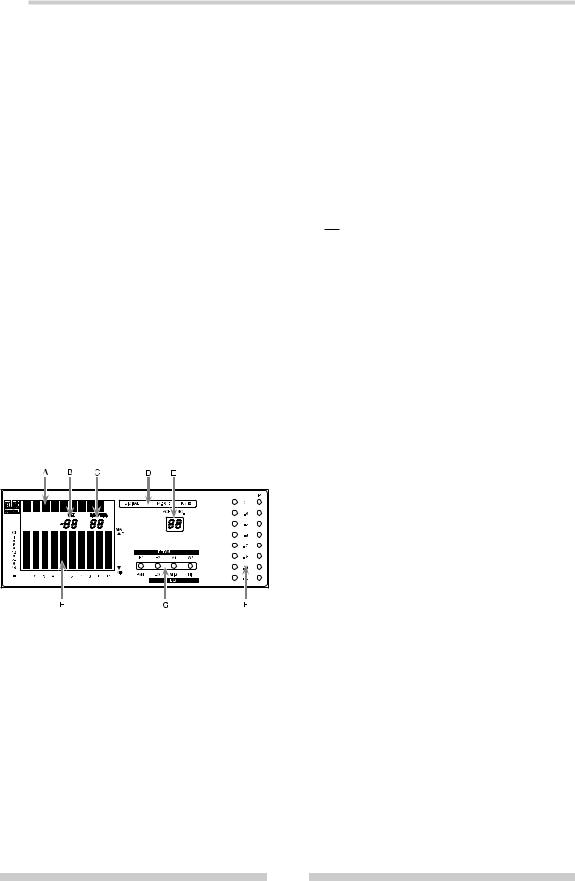


 Model VM88 Owner’s Manual
Model VM88 Owner’s Manual
can be setup. Refer to [Channel parameter edit mode] on page 20 for details.
25. Fader adjust key
This key warns by blinking if a fader position drifts or sound volume is accidentally changed at switch ON of power or at recall of the scene memory.
Use this key to enter the fader adjust mode to manually adjust the fader position. Refer to [Fader adjust mode] on page 31 for details.
26. Channel On/Channel Select key
The channel to be edited can be selected while in the channel parameter edit mode. In other modes, channel ON/OFF is possible. Refer to [Normal mix mode] on page 18 and [Channel parameter edit mode] on page 20 for details.
27. Level adjust key
This key will blink together with of the FADER ADJUST key. The level adjust mode is entered when this key is pressed so the sound level can be matched to the present fader position. Refer to [Level adjust mode] on page 31 for details.
28. Contrast adjusting knob
Adjust he LCD display contrast with this knob. Rotating this knob clockwise increases the contrast.
29. Display/status/meter section
(A) Character display section
Names of the scene memory or various edit modes are displayed.
(B) CHANNEL fader display section
In channel parameter edit mode, the INPUT fader position of the selected channel is displayed in units of 00 ~ 99. Nothing will be displayed in the initial state and the normal mix mode.
(C) MASTER fader display section
The MASTER fader position is displayed in units 00 ~ 99.
(D) Digital in status display section
This displays the [DIGITAL IN] setting in the setup mode, and the external digital input signal status. For details, refer to [IN/OUT of digital signals] in “Normal mix mode” on page 18.
(E) Scene number display
The current scene number is displayed here. Refer to [Scene memory mode] on page 30 for details.
(F) LED level meter display section
The output level of the STEREO BUSS is displayed here. When ST OUT ON/OFF is switched to OFF ( ), all LEDs will blink to indicate that no signal is output from the ST OUT L, R connectors.
), all LEDs will blink to indicate that no signal is output from the ST OUT L, R connectors.
This level meter has a peak hold function, which is adjustable in the setup mode. The initial state peak hold time is set to 1.0 sec. For details, refer to “Setup mode” on page 33.
(G) Status indicator
Using the channel parameter edit mode explained later, what is currently setup can be confirmed by the dot display. Items to be set can be selected with the PAN/EQ key or the EFF/AUX key. Refer to [Channel parameter edit mode] on page 20 for details.
(H) LCD level meter
In normal mix mode, this indicates channels 1 ~ 8 input levels and the stereo buss level. In the various edit modes, the setup status will be displayed. The peak hold function is not provided in the LCD level meter.
30. TRIM knob
These knobs are for adjusting the input gain to match the sound source connected to INPUT 1 ~ 8. These can be adjusted within the range of -50dBu ~ -10dBu for MIC INPUT 1 ~ 4, -30dBu ~ +10dBu for LINE INPUT 1 ~ 4 and -40dBu ~ +4dBu for INPUT 5 ~ 8.
31. Input jack 5 ~ 8
Line level sound sources can be connected to channels 5 ~ 8 input jacks (TRS phone jacks). In the initial setup, the input mode of INPUT 5-6 and INPUT 7-8 are set to stereo so that stereo output sound sources can be connected.
The input mode can also be set for monaural by the setup mode. Trim is adjustable to match the output of the sound source that is connected (Adjusting range: -40dBu ~ +4dBu). To setup of the input mode, refer to “Setup mode” on page 33.
32. Insert jack 1 ~ 4
These jacks are used when using a compressor/limiter on mic sound sources at inputs 1 ~ 4. For details, refer to “Connecting peripheral equipment” on page 9.
6
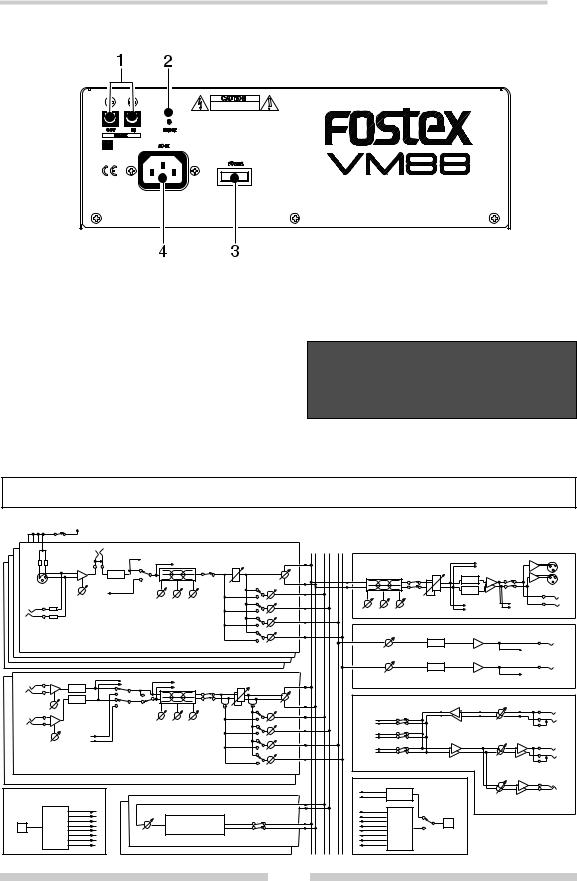
Model VM88 Owner’s Manual 


Rear panel sectin
1. Digital in/out jacks
Digital signals (S/P DIF or ADAT) from external digital equipment can be input to these DIGITAL IN jacks and then assigned to the desired input channel. S/P DIF or ADAT digital signals can be output from the DIGITAL OUT connectors. For details, please refer to “Connecting peripheral equipment” on page 9 and “In/out of digital signals” explained in “Normal mix mode” on page 18.
2. RESET switch
This switch resets the CPU inside VM88. Refer to page 8 for details.
3. POWER switch
The On/Off power switch.
4. AC IN connector [AC IN]
Plug-in the power cable included with the VM88 here.
< NOTE >
If the VM88 is not to be used for long periods (more than one month) be sure to remove the power cable plug from the wall outlet.
|
|
|
Block Diagram |
|
|
|
|
|
|
-48V |
|
|
|
|
|
|
|
|
|
PHANTOM (SETUP) |
|
|
|
|
|
|
|
|
|
|
|
|
ST |
EFF AUX |
|
|
|
|
|
INSERT |
|
|
L R |
1 2 1 2 |
|
|
|
|
|
(-10dBV) |
|
|
|
ST MASTER |
|
|
|
||
|
To DIGI OUT |
|
|
|
|
|
|||
|
|
To METER |
|
|
|
|
To DIGI OUT |
L |
|
|
|
|
|
|
|
|
|
|
|
A/D |
100Hz |
1kHz |
10kHz |
|
|
|
|
|
|
|
|
CH ON |
|
|
|
D/A |
|
R |
|
|
|
|
PAN |
100Hz |
1kHz |
10kHz |
|
||
MIC |
|
|
GAIN |
|
|
|
|
|
ST OUT |
|
|
|
|
|
|
D/A |
|
||
(-10dBu~-50dBu) |
|
|
|
|
|
CH ON |
ST OUT |
(+4dBu) |
|
TRIM |
From DIGI IN |
|
|
|
|
|
|
ST MASTER |
|
L |
|
LO |
MID |
HI |
EFF 1 |
|
|
|
|
R |
|
|
|
|
|
|
|
|
|
To METER |
To MON |
|
|
|
|
|
EFF 2 |
LO |
MID |
HI |
|
|
ST OUT |
|
|
|
|
|
|
|
|
|
(-10dBV) |
|
LINE |
|
|
|
|
|
|
|
|
|
|
(+10dBu~-30dBu) |
|
|
|
AUX 1 |
AUX MASTER |
|
|
|
||
|
|
|
|
|
|
|
||||
CH 1 |
|
|
|
PRE/POST AUX 2 |
|
AUX 1 |
|
D/A |
To MON |
|
|
|
|
|
|
|
|
AUX 1 OUT |
|||
CH 2 |
|
|
|
|
|
MASTER |
|
|
|
(-10dBV) |
CH 3 |
|
|
|
|
|
|
|
|
|
|
CH 4 |
|
|
|
|
|
|
|
D/A |
To MON |
|
|
|
|
|
|
|
AUX 2 |
|
|
AUX 2 OUT |
|
|
|
|
|
|
|
MASTER |
|
|
|
(-10dBV) |
|
To DIGI OUT |
|
|
|
|
|
|
|
|
|
|
|
A/D |
|
To METER |
|
|
|
|
|
|
|
|
|
|
|
|
|
|
|
|
|
|
100Hz |
1kHz |
10kHz |
|
|
|
|
CH5 INPUT |
|
A/D |
|
|
|
|
MON |
|
|
(+4dBu~-40dBu) |
|
|
|
CH ON |
PAN |
|
|
||
|
|
MONO/STEREO |
|
|
|
||||
|
|
|
(SETUP) |
|
|
GAIN |
|
|
|
|
TRIM |
|
DIGI IN |
|
|
|
|
|
L (M) |
|
|
|
(SETUP) |
|
|
|
From AUX 1 |
|
|
|
|
|
LO |
MID |
HI |
EFF 1 |
|
|
R |
|
|
|
|
|
|
||||
CH6 INPUT |
|
|
|
|
|
|
|
AUX 1 |
SUB IN |
|
|
|
|
|
|
From AUX 2 |
|
(-10dBV) |
|
(+4dBu~-40dBu) |
|
|
|
|
|
|
|
||
|
|
|
|
|
EFF 2 |
|
|
|
|
|
|
From DIGI IN |
|
|
|
|
|
|
|
|
|
|
|
|
|
|
AUX 2 |
|
|
|
TRIM |
|
|
|
|
|
From ST |
|
|
|
|
|
|
|
|
|
|
L (M) |
|
|
|
|
|
|
|
AUX 1 |
|
|
|
|
|
|
|
|
|
|
|
|
|
|
|
|
|
|
|
|
|
ST |
R |
|
|
|
|
|
|
|
|
MON SEL |
|
CH5/6 |
|
|
|
|
|
PRE/POST AUX 2 |
|
|
MON OUT |
|
|
|
|
|
|
|
|
(-10dBV) |
|
CH7/8 |
|
|
|
|
|
|
|
|
DIGI OUT |
DIGI IN |
|
|
|
|
|
|
|
|
|
|
|
|
|
|
|
From ST |
S/P DIF |
PHONES |
|
|
|
EFF 1-2 |
|
|
|
|
ENCODE |
(100mW) |
|
|
|
|
|
|
|
|
|
|
|
|
|
To CH1 |
|
|
|
|
From CH1-A/D |
|
|
|
S/P DIF |
To CH2 |
|
|
|
|
From CH2-A/D |
|
|
|
or |
To CH3 |
|
|
ASP |
|
From CH3-A/D |
|
|
|
ADAT |
To CH4 |
|
DIGITAL EFFECT |
|
From CH4-A/D |
ADAT |
|
|
|
DECODE |
To CH5 |
EFF 1 |
EFF MUTE |
From CH5-A/D |
ENCODE |
DIGI OUT |
||
|
To CH6 |
MASTER |
|
|
From CH6-A/D |
|
S/P DIF |
||
DIGI IN |
|
|
|
|
|||||
(SETUP) |
To CH7 |
|
|
|
|
From CH7-A/D |
|
ADAT |
|
|
|
To CH8 |
|
|
|
|
From CH8-A/D |
|
(SETUP) |
7



 Model VM88 Owner’s Manual
Model VM88 Owner’s Manual
Before Operation (IMPORTANT Be sure to read below before first using your VM88.)
* Remove the insulation paper
The VM88 uses a memory back up battery inside. You will find a piece of insulation paper attached to avoid current dissipation.
When using the VM88 for the first time, turn ON the power and then remove the insulation paper.
The insulation paper is easily removed by pulling it in direction of arrow as shown at right.
Insulation paper
* Reset of VM88
It is possible for the computer to malfunction at power ON/OFF or by electro induction noise from lightning. In this happens, switch the power ON/OFF to the VM88 several times.
If it does not return to normal operation, press the rear panel [RESET] switch with a slender ball point pen or similar tool. This returns all settings to the initial figures setup at shipping from the plant.
This procedure can be used to clear all stored scene memories.
<Please remember!>
RESET switch
If reset is executed with the INPUT and MASTER raised simultaneous with start up of this unit, the LEVEL ADJUST key/FADER ADJUST key will blink. This indicates that the VM88 has entered the Level Adjust Mode/Fader Adjust Mode because of the difference between present fader position and the fader position at start up following reset. To exit from this mode, retard all faders to the [MIN] position, and the key blinking will stop.
* Internal battery for the memory back up
The internal battery has a life expectancy of about two years. When the battery runs low and its voltage falls below a certain level, the warning message "BattEmpty" will appear in the display. If you continue to use the unit an old battery, your stored scene memories will be lost when the power is turned off.
Do not try to replace the battery yourself as there are no user-serviceable parts inside. Please ask your Fostex distributor or an authorized service station to do the job.
<Please remember!>
There is an automatic internal battery voltage check function in the VM88. Refer to [Setup mode] on page 33.
8

Model VM88 Owner’s Manual 


Peripheral Equipment Connection
Sound sources and external equipment shown in the examples below can be connected to the VM88’s input and output connectors. When connecting external equipment to the in/out connectors, be sure to switch off power to the VM88.
External Equipment |
Other Mixing Console |
CD Player |
|
or Amplifier |
|||
|
|
||
External Equipment |
|
|
Monitor Speaker System
Microphones
Amplifier
Guitar & Guitar Processor
|
|
|
|
|
INPUT |
|
|
|
|
|
|
|
AUX SEND |
|
|
|
ST OUT |
|
|
|
|
MIC |
|
|
MIC |
|
|
MIC |
|
|
MIC |
|
|
|
|
|
|
L |
|
|
|
2:HOT |
|
|
2:HOT |
|
|
2:HOT |
|
|
2:HOT |
|
|
|
|
|
|
2:HOT |
|
|
|
|
|
|
|
|
|
|
|
|
|
|
1 |
|
2 |
|
|
|
|
|
|
|
|
|
|
|
|
|
|
|
|
|
|
|
|
|
|
BAL/+4dBu |
|
|
|
LINE |
|
|
LINE |
|
|
LINE |
|
|
LINE |
|
|
|
|
|
L |
|
R |
|
|
|
|
|
|
|
|
|
|
|
|
|
|
|
|
|
UNBAL/-10dBV |
||
|
|
|
|
|
|
|
|
|
|
|
|
|
|
|
INPUT |
|
|
|
|
|
|
INSERT |
|
|
INSERT |
|
|
INSERT |
|
|
INSERT |
|
|
|
|
|
|
|
|
|
1 |
|
|
2 |
|
|
3 |
|
|
4 |
|
|
5 |
|
6 |
|
7 |
8 |
|
|
LINE |
|
|
LINE |
|
|
LINE |
|
|
LINE |
|
|
|
|
|
|
|
|
|
|
MIC |
|
|
MIC |
|
|
MIC |
|
|
MIC |
|
|
|
|
|
|
|
|
|
+10 |
|
-30 |
+10 |
|
-30 |
+10 |
|
-30 |
+10 |
|
-30 |
+4 |
-40 |
+4 |
-40 |
+4 |
-40 |
+4 |
-40 |
-10 |
[dBu] |
-50 |
-10 |
[dBu] |
-50 |
-10 |
[dBu] |
-50 |
-10 |
[dBu] |
-50 |
|
[dBu] |
|
[dBu] |
|
[dBu] |
[dBu] |
|
|
|
|
|
|
|
|
|
|
|
TRIM |
|
|
|
|
|
|
|
|
|
|
MON IN |
MON OUT |
FOOT SW |
||
R |
|
|
|
|
|
2:HOT |
|
|
|
|
|
L (MONO) |
L (MONO) |
|
|
||
|
R |
|
R |
PHONES |
|
|
GAIN |
|
GAIN |
|
GAIN |
OFF |
|
|
|
|
|
ON |
|
|
|
|
|
-∞ |
+6 |
-∞ |
+6 |
MIN |
MAX |
[dB] |
[dB] |
|
|
||
MON SEL
ST |
AUX 1 |
AUX 2 |
ST OUT |
MONITOR |
|
Foot Switch
Headphones
Compressor/Limitter
multitrackerX-14
Multitracker
|
|
|
|
|
|
|
|
|
Keyboard |
|
Keyboard |
Digital Master Recorder
CAUTION
OUT |
IN |
RESET |
DIGITAL
AC IN
POWER
FD-8 |
AC outlet
<Please remember!>
If external digital equipment to be connected is provided with only COAXIAL (RCA pin jack) type IN/ OUT connectors, use the optional Fostex COP-1/96k optical-coaxial converting adaptor sold separately.
9
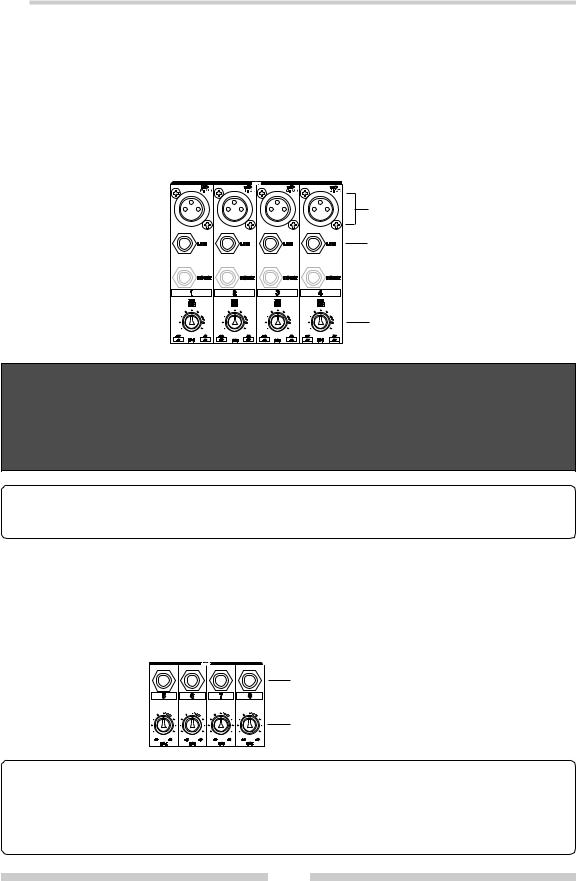


 Model VM88 Owner’s Manual
Model VM88 Owner’s Manual
(1) INPUT 1 ~ 4 connectors
Two types of connectors - Canon connectors (XLR-3-31 type) and TRS phone jacks - are provided for INPUT 1 ~ 4 and either can be used to input of signals depending on the application. Refer to < NOTES > below.
Canon connectors that comply to mic/line levels and microphones are connected here in most cases. Condenser type mics requiring phantom power can be connected because phantom power is provided to these connectors. Also, you can trim within a range of -50dBu ~ -10dBu to match the equipment connected.
Line level sound sources can be plugged into the TRS phone jacks, which complies to both TRS type and common phone plugs. The same as with the Canon connectors, trim is possible within a range of -30dBu ~ +10dBu to match the output level of the equipment connected.
Canon connectors (balanced: 2 HOT)
TRS phone jacks (balanced)
TRIM knobs for use the INPUT 1-4
< NOTES >
*The Canon connector and TRS phone jack of each channel cannot be used in parallel. Use either input only. A malfunction could occur if both are used at the same time.
*Be sure to switch off the power to the VM88 or switch off the phantom power when plugging or unplugging microphone cables.
*Do not switch on the phantom power when using a dynamic mic. This could damage the microphone.
< NOTICE>
When using condenser microphones that require phantom power, first check “On/Off setting of phantom power” explained later in “Setup mode” (Initially set at off). For details, refer to “Setup mode” on page 33.
(2) INPUT 5 ~ 8 connectors
INPUT 5 ~ 8 are TRS phone jacks and line level sound sources can be plugged in here. The input mode (stereo or monaural) of the input connectors INPUT 5-6 and 7-8 can be changed depending on the application. Initially, the input mode of INPUT 5-6 and 7-8 are set to stereo.
The input jacks comply to both TRS type and common phone plugs, and just as with INPUT 1 ~ 4, the input level can be trimmed within a range of -40dBu ~ +4dBu to match the output level of the equipment connected.
TRS phone jacks (balanced)
TRIM knobs for use the INPUT 5-8
< Please remember! >
The input mode (stereo/mono) of INPUT 5-6 and 7-8 can be changed to match the application. Initially, they are set for stereo and thus stereo signals can be input to INPUT 5-6 and 7-8.
For example, if INPUT 5-6 are set to mono, the INPUT 5 jack will be effective and a signal input to INPUT 5 will be simultaneously sent to channels 5 and 6. For details on setup of the input mode, refer to “Setup mode” on page 33.
10

Model VM88 Owner’s Manual 


(3) INSERT 1 ~ 4 jacks
INSERT 1-4 jacks are used when a compressor/limiter is applied to the mic input signals into INPUT 1-4, as shown in the previous connecting example. The in/out are TRS phone jacks and standard input/output levels are -10dBV. 
TRS phone jacks
< Please remember! >
When connecting a compressor/limiter to the INSERT jack, be sure to use the connecting cables shown
below. |
RING: RETURN |
To compressor/limiter input jack |
To VM88 INSERT jack
TIP: SEND
(4) ST OUT L, R connectors
Balanced output Canon connectors (XLR-3-32 type) and unbalanced output phone jacks are provided for ST OUT L, R, either of which can be selected depending on the application. Amplifiers and other mixers are connected here. The standard output level is balanced output +4dBu and unbalanced output -10dBV.
Canon connectors (balanced: 2 HOT)
Phone jacks (unbalanced)
< Please remember! >
Outputs from the ST OUT L, R connectors can be ST OUT ON/OFF switch switched on/off with the ST OUT ON/OFF switch.
For details, refer to “Normal mix mode” on page 15.
(5) DIGITAL IN/OUT jacks (Rear panel)
A digital signal (S/P DIF or ADAT) from external digital equipment is input to the DIGITAL IN jack; these signals can be applied to any input channel. From the DIGITAL OUT jack, mixed signal, which is the same as those output from the ST OUT L, R connectors can be output in digital (S/P DIF) or the INPUT 1-8 input signals can be directly output in digital (ADAT) signal. If ADAT is selected, the input signal prior to being affected by the INPUT fader and EQ can be output digitally.
< Please remember! >
If a digital signal (S/P DIF or ADAT) is to be input to VM88 or a digital signal (S/P DIF or ADAT) is to be output from the VM88, it will be necessary to setup the system clock and DIGITAL IN or DIGITAL OUT modes. For details, refer to “Normal mix mode” on page 15 and “Setup mode” on page 33.
11
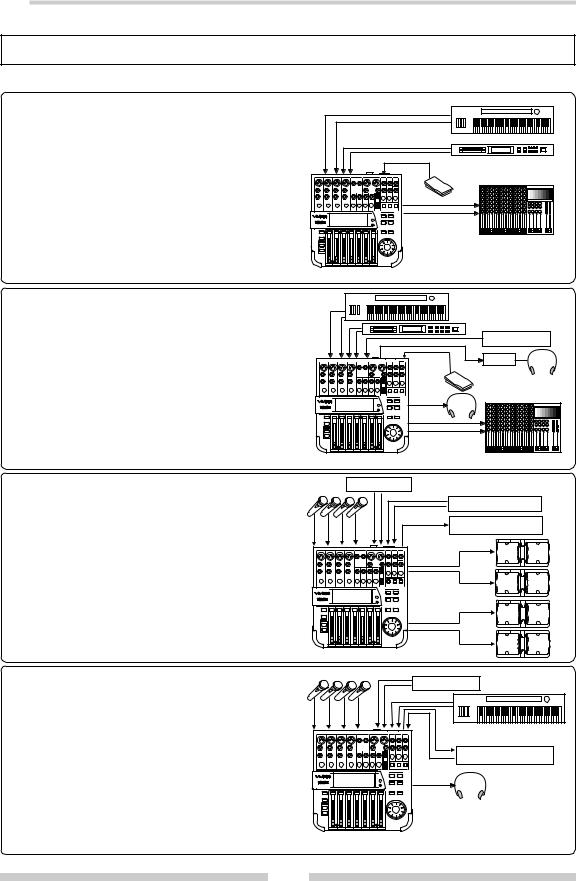


 Model VM88 Owner’s Manual
Model VM88 Owner’s Manual
Application Examples
The following are actual examples in application of VM88 and could be helpful in your application.
< Example 1 > :
As a live performance keyboard mixer
The VM88 can be used as a submixer for keyboards and sound source modules. Scene memory in which the sound balance has been set can be switched with a foot switch.
Keyboard
Sound module
VM88 |
Model 8051
PA mixer
< Example 2 > :
As a live performance keyboard mixer with sync
In addition to the keyboard and sound source module mix, playback of ADAT sound can be mixed simultaneously. By outputting a track containing a click from the AUX SEND jacks via the pre-fader, a cue can be sent to the monitor headphone and the drummer.
|
Keyboard |
|
Sound module |
|
Digital Recorder |
ADAT |
D-108 etc. |
AUX |
PH50 |
|
|
|
Headphone |
|
Model 8051 |
|
PA mixer |
VM88 |
|
< Example 3 > :
As a small PA mixer
The VM88 can be used as a PA mixer with two channels of monitor sends.
Balance can be pre-stored in the scene memory and sequentially called in accordance to the script.
< Example 4 > :
As a recording mixer (overdub) for an ADAT recorder
Overdubbing of ADAT or one-time recording of 8 tracks is possible by setting Digital In to [ADATAll Ch] and Digital Out to [ADAT Dir].
Playback monitor level is adjusted via the fader and the recording level by the TRIM knob.
CD player |
|
|
|
|
Sound module |
|
|
Recorder |
|
|
SPA11 |
|
|
(main) |
AUX 1 |
|
|
|
|
SPA11 |
AUX 2 |
|
(monitor) |
|
|
|
VM88 |
|
|
Sound source |
||
|
ADAT |
Keyboard |
|
|
|
|
|
Digital recorder |
|
ADAT |
D-108 etc. |
|
|
|
|
|
Headphone |
VM88 |
|
|
12
